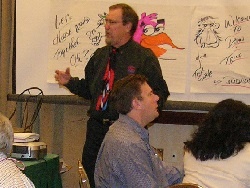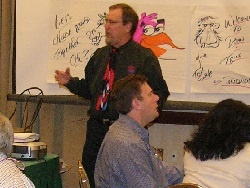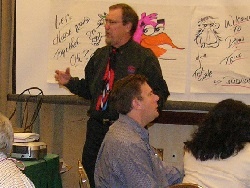


At The Bob Pike Group, we have a few workshop offerings focused on management development. One of those courses is our Business Presentation Skills because, no matter the role you play at your workplace, you are judged by how you present. The type of presentation you give depends on its purpose. Whether it's reporting progress, leading a meeting to solve a problem or make a decision, providing information or inspiration, training someone - you're judged by how well organized your presentation and process is - and by how well you execute it.
In business, there are six types of presentations commonly used. Let’s examine each of them. Keep in mind, however, that not every presentation that you will want to make will lend itself to one of these formulas, but they are a good place to start. Then, you can modify and adapt to meet your specific needs.
Type 1: Providing Information
Your organization is considering going to five different tradeshows. Your presentation might provide information on the five different trade shows, the demographics of the attendees, and their purchasing power. Or, the presentation might be on the final day of the conference and the purpose of your presentation would be to inform people of next year’s time, date, and location, as well as what they can expect to see and hear.
Type 2: Teaching a Skill
You have installed a new security system, and you are making a presentation to the staff on how to disarm the security system when entering the premises, how to notify the monitoring company when on the premises, and how to rearm the system when leaving the premises.
Type 3: Reporting Progress
Your company has launched an “In-Touch” calling campaign. Each person in the company is calling current and past clients to let them know about an upcoming event. The purpose of your presentation might be to update everybody at a staff meeting on the progress that each of the company teams is making toward the overall goal of 3,000 phone calls.
Type 4: Selling a Product, Service, or Strategy
A company is hiring a lot of new people. However, the time it takes to train them on new computer software isn’t cost effective. To successfully sell your product, get the listener’s attention, maintain the listener’s interest, create desire in the listener and then ask the listener to take action—when should the new software be installed?
Type 5: Obtaining a Decision
Your organization is going to have a company outing. Some of the possibilities are a company picnic, a boat cruise, or a day at an amusement park. When giving your recommendation, you may want to list the must-haves and the nice-to-haves for the outing. Then, you can show how each of the possibilities stacks up against the musts and wants. To wind up, you state the preferred option and ask for a decision.
Type 6: Solving a Problem
At peak times of the year, your company experiences shipping backlogs beyond what your customers think is reasonable. Your presentation could include stating the problem, presenting facts concerning the problem, identifying causes, stating the ideal outcome, presenting possible solutions, and voicing your recommendations.
Knowing the objective of your presentation can be helpful in determining the type of presentation. If your purpose is to inform, then you are likely to use one of the first three types of presentations discussed below. However, if your objective is to persuade, then you would use one of the last three presentation types.
Our Business Presentation Skills course is a participant-centered workshop focusing on the fundamentals of organizing and delivering high impact presentations, such as more in-depth information on the types of presentations used and how to prepare for each, and practical application of presentation tips including body language, voice, gestures, and delivery style of adult learning. There is tremendous emphasis on application, practice, and video as well as self and peer feedback. For more information on this workshop, click here.
Don't miss out on updates and chances
to sharpen your skills with participant-centered learning.




3740 N Chestnut St #113 - Chaska, MN 55318-3053